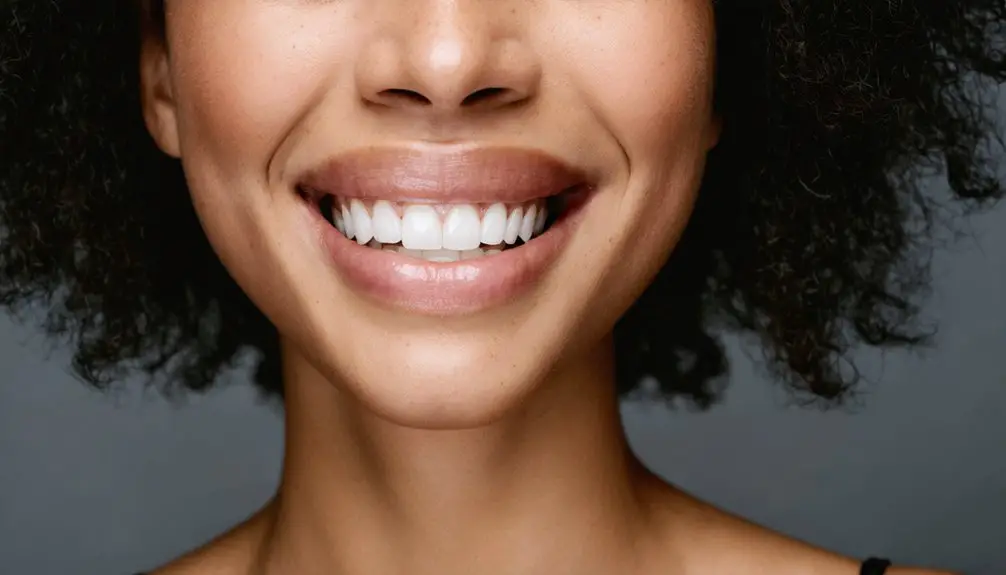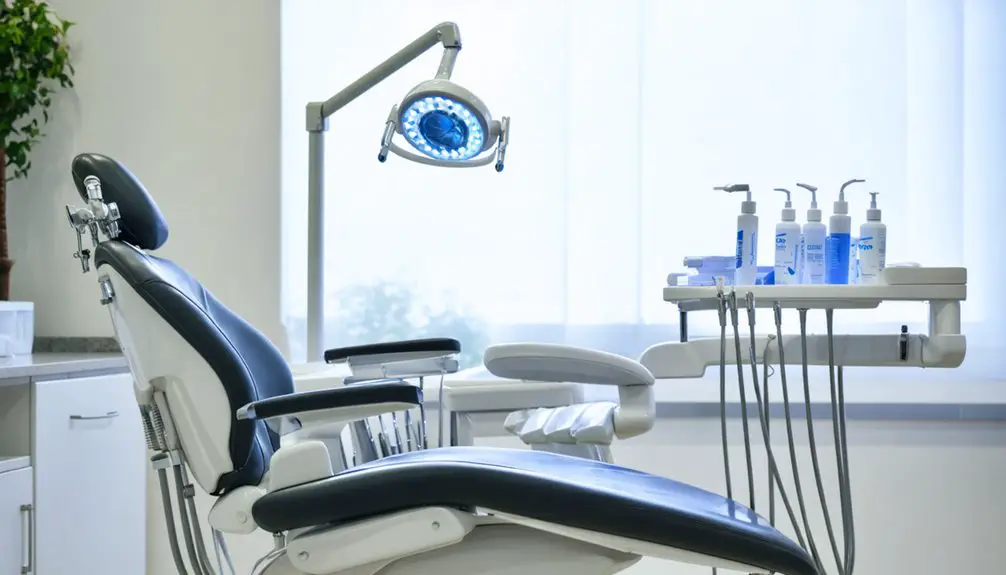You’ll achieve lasting professional teeth whitening results by combining in-office treatments with proper aftercare. Start with a professional cleaning, then undergo high-concentration peroxide treatments that can lighten teeth up to eight shades. Protect your investment by avoiding staining foods and beverages for 48 hours post-treatment, using a straw when drinking dark liquids, and maintaining thorough oral hygiene. Understanding the science behind whitening treatments and sensitivity management will help maximize your bright smile’s longevity.
Key Takeaways
- Choose professional in-office treatments with high-concentration peroxide formulas for dramatic, long-lasting results that can endure 1-3 years.
- Schedule professional cleaning before whitening treatment and maintain regular dental visits to remove surface stains and plaque.
- Avoid dark-colored foods and beverages for 48 hours post-treatment, and use straws when consuming staining substances thereafter.
- Practice thorough daily oral hygiene with whitening toothpaste, soft-bristled brushes, and proper brushing techniques.
- Use desensitizing products containing fluoride or potassium nitrate before and after treatment to manage sensitivity and protect enamel.
Understanding Professional Teeth Whitening Options
When considering professional teeth whitening options, it’s essential to understand the range of treatments available through dental professionals.
You’ll find several in-office options that deliver faster, more dramatic results than over-the-counter products, including laser treatments, Zoom whitening, and traditional peroxide-based procedures. Professional treatments typically last 1-3 years before needing touch-ups.
Today’s whitening technologies incorporate high-concentration peroxide formulas, ranging from 25% to 44%, activated through various methods.
Modern teeth whitening treatments utilize potent peroxide solutions between 25-44%, activated using advanced technological methods for optimal results.
Laser whitening offers precise results with enhanced sensitivity protection, while Zoom treatments can lighten teeth up to eight shades in 90 minutes using LED activation. Natural alternatives using bio-based whitening agents are becoming increasingly popular for those seeking gentler treatment options.
For a more gradual approach, custom-fitted trays provide consistent whitening at home under professional supervision.
Each method includes protective measures to shield your gums and soft tissues, ensuring both safety and effectiveness during the whitening process.
The Science Behind Long-Term Whitening Success
Understanding the science of long-term whitening success helps explain why professional treatments deliver superior results compared to over-the-counter alternatives.
The whitening chemistry involves high-concentration peroxide agents that penetrate deep into your enamel, breaking down stain molecules at their core. Professional supervision guarantees ideal balance between effectiveness and enamel integrity. Technologies like LED light therapy enhance the whitening process for more dramatic results.
Your results’ longevity depends on both biological and behavioral factors. While color regression can occur within weeks due to enamel dehydration, maintaining proper oral hygiene greatly extends whitening effects. Professional results can last up to three years with proper care.
You’ll find that professional treatments often motivate better oral care habits, leading to improved hygiene levels even a year after the procedure. Additionally, protecting your enamel through conscious dietary choices and avoiding staining substances helps preserve your whitening results.
Maximizing Your Whitening Treatment Results
To maximize your whitening treatment results, several key factors must work in harmony, from selecting the most suitable whitening method to maintaining proper oral health throughout the process.
Despite common whitening myths, treatment timelines vary greatly based on your stain type and severity. You’ll achieve ideal results by first addressing any existing dental issues and ensuring your teeth are professionally cleaned. Some underlying health conditions may limit how well whitening works for you.
Before starting any whitening regimen, get a professional cleaning and address dental problems to ensure optimal treatment success.
If you’re dealing with extrinsic stains, professional in-office treatments will deliver faster outcomes, while intrinsic discoloration requires longer-term approaches. Using high-quality whitening products is essential for achieving safe and effective results.
Your success also depends on consistent post-treatment care. Maintain rigorous oral hygiene, avoid staining substances, and follow your dentist’s recommended maintenance schedule.
Remember that your genetic makeup and age influence whitening effectiveness, so work with your dental professional to develop realistic expectations and personalized treatment plans.
Essential Aftercare and Maintenance Strategies
You’ll need to adopt specific daily habits to protect your newly whitened smile from common staining agents like coffee, wine, and tobacco.
Using a straw while drinking beverages that can stain teeth helps minimize direct contact with tooth surfaces.
Scheduling regular dental cleanings helps remove plaque buildup and surface stains that can dull your whitening results.
To maintain your professional results, it’s crucial to follow proper oral hygiene practices, including twice-daily brushing with whitening toothpaste and daily flossing.
Regular dental check-ups, combined with periodic touch-up treatments and protective measures against enamel damage, will help extend the longevity of your whitening investment.
Daily Stain Prevention Tips
Maintaining professional whitening results requires a thorough daily strategy focused on preventing new stains from developing.
You’ll need to make careful daily dietary adjustments, particularly in the first 48 hours after treatment when your teeth are most vulnerable. Avoid dark-colored foods and beverages, or use a straw when consuming them to minimize contact with your teeth. Your teeth become temporarily more porous during this period, making them especially susceptible to new stains.
Implement effective brushing techniques using a soft-bristled or electric toothbrush twice daily, but wait 30 minutes after consuming acidic items. An electric toothbrush can remove up to 100% more plaque and surface stains compared to manual brushing. Rinse with water immediately after exposure to staining substances, and use whitening toothpaste containing hydrated silica and peroxide agents.
For peak protection, choose dental products with anti-redeposition agents and calcium phosphate components to prevent stain buildup while supporting enamel health.
Extending Professional Results Long-term
While professional teeth whitening delivers dramatic results, preserving that brightness requires an all-encompassing maintenance strategy combining periodic touch-ups, diligent oral care, and lifestyle adjustments.
To maintain your brilliant smile, schedule dentist-supervised touch-up techniques every six months, limiting sessions to two per period to minimize sensitivity.
You’ll need to modify your diet by avoiding staining substances like coffee, red wine, and dark berries. When you do indulge, rinse immediately with water. Dietary considerations should include calcium-rich foods and non-acidic options that protect your enamel.
Don’t forget to maintain regular dental cleanings, which remove surface stains and support enamel health.
Combine these efforts with thorough daily oral hygiene – including brushing, flossing, and tongue cleaning – to protect your investment in a brighter smile.
Addressing Common Sensitivity Concerns

You’ll likely experience some temporary tooth sensitivity after your professional whitening treatment, particularly to hot and cold temperatures, but this discomfort typically resolves within 1-2 days.
To minimize post-treatment sensitivity, you can use desensitizing products containing potassium nitrate or fluoride, and avoid extreme temperature foods and beverages during the recovery period.
Your gums may also feel tender following treatment, so maintaining gentle but thorough oral hygiene practices will help protect your gum health while your mouth adjusts to the whitening results.
Minimizing Post-Treatment Discomfort
Despite the remarkable results of professional teeth whitening, many patients experience temporary sensitivity following treatment. You can greatly minimize discomfort by implementing targeted strategies that focus on protecting and strengthening tooth structure.
Here’s what you can do to reduce post-treatment sensitivity:
- Apply desensitizing agents containing potassium nitrate and fluoride before and after treatment to block nerve sensitivity.
- Choose lower-concentration whitening formulas (10-16%) when possible, extending treatment time rather than risking discomfort.
- Space out treatment sessions to allow for proper enamel remineralization between applications.
- Use pH-balanced products and avoid harsh oral care items immediately after whitening.
Managing Temperature Sensitivity
Because temperature sensitivity commonly occurs after teeth whitening, understanding how to manage hot and cold reactions is crucial for patient comfort.
Several temperature relief techniques can help minimize discomfort during the recovery period. You’ll want to avoid extremely hot or cold beverages and use sensitivity toothpaste regularly until symptoms subside.
For effective sensitivity management strategies, reduce exposure to acidic foods and incorporate remineralizing agents like fluoride products into your post-treatment care routine.
If you’re experiencing heightened sensitivity, consider spacing out your whitening sessions to allow proper healing time.
Professional supervision guarantees controlled application and monitoring of the whitening process.
Remember that sensitivity is typically temporary, and your teeth will gradually return to normal as minerals are restored and dentin tubules reseal.
Protecting Your Gum Health
While managing temperature sensitivity is important, protecting your gums during the whitening process requires equal attention.
Gum irritation and chemical burns can occur when bleaching agents come into contact with sensitive gum tissue, appearing as white patches, redness, or peeling similar to mild sunburn.
To safeguard your gum health during whitening treatments:
- Choose custom-fitted trays over generic options to prevent gel leakage onto gums.
- Follow product instructions precisely, never exceeding recommended application times.
- Use protective barriers like dental dams during professional whitening sessions.
- Avoid whitening if you have active gum disease or inflammation.
If you experience persistent gum sensitivity, rinse with saltwater or fluoride mouthwash to promote healing.
For severe symptoms lasting more than a few days, seek professional evaluation immediately.
Advanced Solutions for Stubborn Stains

When traditional whitening methods fall short, advanced professional solutions offer powerful options for treating stubborn tooth discoloration. For challenging intrinsic stains, you’ll find several effective treatments tailored to your specific needs.
Professional-grade whitening treatments use concentrated peroxide formulas with customized trays or laser acceleration to penetrate deep stains more effectively than over-the-counter products.
For severely resistant discoloration, porcelain veneers provide a long-lasting solution by completely masking stubborn stains while correcting other cosmetic concerns.
Dental bonding offers a less invasive alternative for localized staining, while microabrasion can address surface-level intrinsic discoloration through gentle removal of affected enamel.
Your dentist will help determine which advanced technique best suits your situation, considering factors like enamel thickness and existing dental work.
Frequently Asked Questions
Can I Whiten My Teeth While Wearing Braces or Other Dental Appliances?
Like threading a needle, whitening options exist during braces but aren’t ideal. You’ll get better results waiting until after braces removal, though clear aligners allow more flexibility with whitening treatments.
How Soon After Whitening Treatment Can I Get Dental Work Done?
For ideal whitening safety and minimal dental sensitivity, you’ll need to wait 2-4 weeks before getting dental work done. Specific procedures may require different waiting periods, so consult your dentist first.
Will Whitening Treatments Affect Existing Dental Fillings or Crowns?
While 90% of people seek whiter smiles, you won’t see filling discoloration or crown sensitivity from whitening treatments. Your existing restorations will maintain their original color since they can’t absorb whitening agents.
Are Natural Teeth Whitening Methods Like Charcoal or Oil Pulling Effective?
Natural methods aren’t highly effective for whitening. Charcoal effectiveness is limited and can damage your enamel, while oil pulling benefits don’t include significant whitening. Stick with proven professional whitening treatments.
Can Pregnant or Nursing Mothers Safely Undergo Professional Teeth Whitening Treatments?
Bright as your future may be, you shouldn’t undergo professional teeth whitening while pregnant or nursing. Due to safety concerns about chemical exposure, it’s best to wait until after these periods.
References
- https://www.champaigndentalgroup.org/about-us/blog-articles/top-professional-teeth-whitening-techniques-2024-effective-safe
- https://lanedds.com/which-teeth-whitening-technique-lasts-longest/
- https://pmc.ncbi.nlm.nih.gov/articles/PMC4058574/
- https://www.arthurglosmandds.com/blog/different-methods-of-teeth-whitening/
- https://www.culvercitydentist.com/blogs/teeth-whitening/laser-vs-zoom-whitening
- https://pmc.ncbi.nlm.nih.gov/articles/PMC10302806/
- https://pmc.ncbi.nlm.nih.gov/articles/PMC8352057/
- https://www.eastridgedentalgreenbay.com/how-long-do-teeth-whitening-results-last-tips-for-longevity/
- https://www.drjoycedentistry.com/patient-education/teeth-whitening-westwood-professional-care-benefits
- https://progrin.com/blog/the-science-and-art-of-professional-teeth-whitening/



